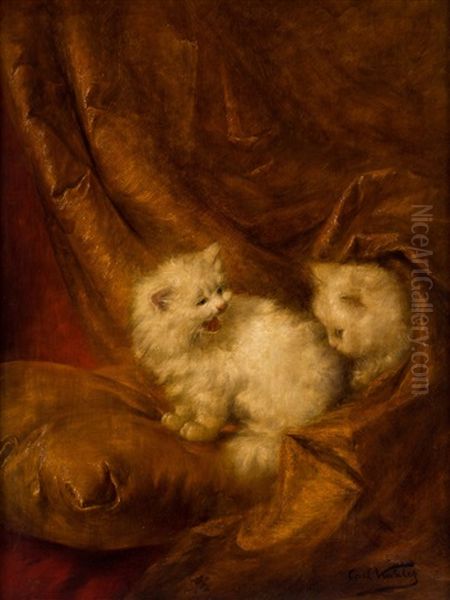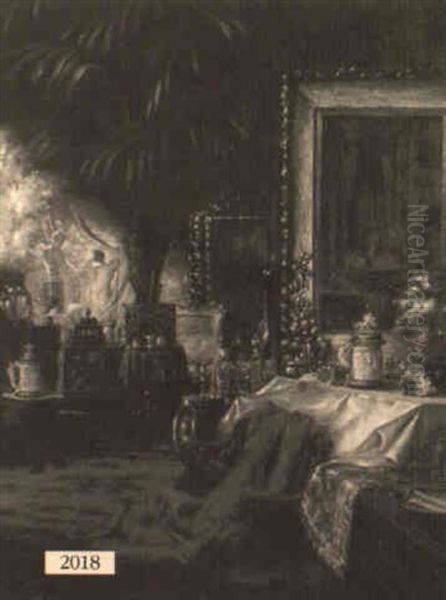Carl Kahler, an Austrian artist of the late 19th century, carved a unique niche for himself in the annals of art history, primarily through his captivating depictions of felines and his insightful genre scenes. His life was a fascinating tapestry woven across continents, from the esteemed art academies of Europe to the burgeoning colonial societies of Australia and finally to the vibrant artistic landscape of the United States. While he produced a diverse body of work, including portraits and depictions of social events, it is his extraordinary ability to capture the enigmatic charm of cats that has secured his most enduring legacy.
Early Life and Academic Foundations
Born in Linz, Austria, in 1855 (some sources cite 1856), Carl Kahler embarked on his formal artistic training at a relatively young age. On October 19, 1874, he enrolled at the prestigious Academy of Fine Arts in Munich (Akademie der Bildenden Künste München). This institution was a powerhouse of artistic education in Europe at the time, known for its rigorous curriculum and its role in fostering the Munich School, which emphasized realism, technical skill, and often, a somewhat dark, rich palette.
During his time in Munich, Kahler studied under notable masters such as Ludwig von Löfftz and Wilhelm Lindschmidt the Younger. Ludwig von Löfftz was a respected German painter known for his genre scenes and religious subjects, and later became a professor and director of the Munich Academy. His emphasis on careful drawing and composition would have undoubtedly influenced Kahler. Wilhelm Lindschmidt the Younger, also a professor at the Academy, was known for his historical and genre paintings, contributing to the academic environment that prized narrative clarity and technical proficiency. The training Kahler received here would have provided him with a strong foundation in anatomy, perspective, and the traditional techniques of oil painting, skills that are evident throughout his diverse oeuvre. The influence of the Munich School, with artists like Wilhelm Leibl championing a form of direct realism, would have been part of the artistic air Kahler breathed.
Parisian Sojourn and Broadening Horizons

Following his academic studies in Munich, Carl Kahler, like many aspiring artists of his generation, sought to further refine his skills and broaden his artistic horizons in Paris. The French capital was, at that time, the undisputed center of the Western art world, a melting pot of established academic traditions and revolutionary new movements. While the specific dates of his Parisian stay and the particular ateliers he may have frequented are not extensively documented for Carl Kahler himself, the experience would have exposed him to a dazzling array of artistic styles.
Paris in the late 1870s and early 1880s was a city of artistic ferment. The official Salon, dominated by academic painters like Jean-Léon Gérôme and William-Adolphe Bouguereau, still held considerable sway, championing meticulously finished historical, mythological, and allegorical scenes. Simultaneously, Impressionism, with artists such as Claude Monet and Edgar Degas, had already challenged academic conventions with its focus on capturing fleeting moments and the effects of light and color. While Kahler's own work remained largely within a realist framework, his time in Paris would have provided invaluable exposure to diverse artistic philosophies and techniques, enriching his visual vocabulary. After this period of further study, he exhibited his works in prominent European art centers including Berlin, Vienna, and Munich, signaling his growing reputation.
The Australian Chapter: Portraits and a Nation's Pastime
In 1885, Carl Kahler made a significant life change, relocating to Australia. He settled in Melbourne, a city that was then experiencing a period of considerable growth and cultural development, partly fueled by the wealth generated from gold rushes. In Melbourne, Kahler established a studio and initially focused on portraiture, a genre that was in high demand among the prosperous colonial society. His academic training and refined technique would have made him a sought-after artist for capturing the likenesses of prominent citizens.
Beyond portraiture, Kahler became particularly noted for his involvement in documenting one of Australia's most iconic social and sporting events: the Melbourne Cup. This prestigious horse race was, and remains, a central fixture in Australian culture. Kahler created several large-scale paintings depicting the vibrant atmosphere of the Melbourne Cup, capturing not just the race itself but the crowds, the fashion, and the social interactions surrounding the event. One of his most famous works from this period is The Betting Ring. This painting is a remarkable social document, offering a panoramic view of the diverse assembly of people at the racetrack, from wealthy patrons to everyday punters, each figure rendered with attention to character and detail. These works demonstrate Kahler's skill as a genre painter, capable of orchestrating complex multi-figure compositions and conveying the energy of a specific time and place.

During his time in Australia, Kahler was part of a diverse community of artists, including other European immigrants who contributed to the richness of Melbourne's art scene. Figures such as the Italian-born Girolamo Nerli, known for his impressionistic style, and Ugo Catani, another Italian artist, were his contemporaries. The French-born Madame Mouchette (Berthe Mouchette) and Arthur Loureiro, who arrived via Paris, also added to the cosmopolitan artistic milieu. Kahler's contributions, particularly his grand depictions of public life, provided a European academic perspective to the developing Australian art identity.
The Feline Muse: "My Wife's Lovers" and a Specialized Fame
While Kahler achieved success in Australia with portraits and genre scenes, his most distinctive and internationally recognized works emerged from an unexpected commission that steered his artistic focus towards a new subject: cats. In 1891, while in the United States (having moved there from Australia), Kahler was commissioned by Kate Birdsall Johnson, a wealthy American philanthropist and art patron living in San Francisco. Mrs. Johnson was an ardent cat lover, reputedly owning 350 cats on her estate near Sonoma, California. She commissioned Kahler to create a monumental painting of 42 of her beloved Persian and Angora cats.
The resulting masterpiece, titled My Wife's Lovers, is arguably Carl Kahler's most famous work and a landmark in the genre of animal painting. The title itself is said to have been coined by Mrs. Johnson's husband, who humorously referred to her feline companions as her "lovers." The painting is enormous, measuring approximately 6 by 8.5 feet (177.8 x 258.4 cm), and showcases Kahler's extraordinary patience and skill. He reportedly spent three years meticulously studying the cats, sketching them individually to capture their unique personalities, poses, and expressions before composing the final group portrait.
My Wife's Lovers is a tour-de-force of animal portraiture. Each of the 42 cats is rendered with remarkable individuality, their luxurious fur, distinct markings, and characteristic feline attitudes brought to life with Kahler's precise brushwork. The composition is dynamic, with cats lounging, preening, playing, and gazing intently, creating a lively and engaging scene. The central figure is said to be a cat named Sultan, a particular favorite of Mrs. Johnson, for whom Kahler also painted a separate portrait. This magnificent cat, depicted at the top of the composition in My Wife's Lovers, was reportedly purchased by Mrs. Johnson for a significant sum in Paris. The painting was exhibited at the 1893 Chicago World's Fair, where it garnered considerable attention and acclaim, solidifying Kahler's reputation as a preeminent painter of cats. Its sheer scale and the charming subject matter made it a popular sensation.
Artistic Style: Realism, Detail, and Empathy
Carl Kahler's artistic style is characterized by a strong adherence to realism, meticulous attention to detail, and a sympathetic understanding of his subjects, particularly animals. His academic training in Munich provided him with the technical facility to render textures, forms, and light with precision. This is especially evident in his cat paintings, where the softness of fur, the glint in an eye, and the subtle nuances of feline anatomy are depicted with convincing naturalism.
Unlike some animal painters who might romanticize or overly sentimentalize their subjects, Kahler's approach, while affectionate, was rooted in careful observation. His dedication to spending years studying cats for My Wife's Lovers underscores his commitment to capturing their true nature. He didn't just paint generic cats; he painted individual feline personalities. This ability to convey character set his work apart. In this, he shares a kinship with other great animal painters like the British Sir Edwin Landseer, who was renowned for imbuing his animal subjects with almost human-like emotions and character, or the Dutch-Belgian artist Henriëtte Ronner-Knip, a contemporary who also specialized in charming and highly detailed paintings of cats and dogs in domestic settings. The French artist Rosa Bonheur, celebrated for her powerful and realistic depictions of animals, also worked within a similar tradition of respect for animal subjects combined with technical mastery.
Kahler's genre scenes, such as The Betting Ring, also demonstrate his keen observational skills and his ability to manage complex compositions with numerous figures. He adeptly captured the social dynamics and the specific atmosphere of the events he depicted. His palette, while capable of richness, was generally naturalistic, serving the descriptive clarity of his paintings.
Later Years in America and Enduring Legacy
After his success with My Wife's Lovers, Carl Kahler continued to work in the United States. He had moved to America in the early 1890s, and it was here that his specialization in cat painting truly flourished, largely thanks to the patronage of individuals like Kate Birdsall Johnson. The Gilded Age in America saw a rise in wealth and a corresponding interest in art collecting and commissioning, providing opportunities for skilled European artists like Kahler.
He spent his later years in San Francisco, a city with a burgeoning art scene at the turn of the 20th century. Artists like William Keith, known for his Californian landscapes, and Thomas Hill, famous for his grand depictions of Yosemite, were part of this environment, though Kahler's focus remained distinct. Sadly, Carl Kahler's life was cut short. He died in San Francisco in 1906, at the age of 49 (or 50, depending on the birth year used), reportedly as a result of the great San Francisco earthquake.
Despite his relatively short career, Carl Kahler left behind a significant body of work. While his portraits and Australian genre scenes are important contributions, his fame today rests overwhelmingly on his cat paintings, especially My Wife's Lovers. This painting, after Mrs. Johnson's death, went through various collections and continues to captivate audiences. It was sold at auction for a substantial sum in 2015, attesting to its enduring appeal and artistic merit. The work has been widely reproduced and is celebrated by cat enthusiasts and art lovers alike as one of the greatest cat paintings ever created.
Carl Kahler's journey from the academies of Europe to the new worlds of Australia and America reflects the globalized nature of the art world even in the 19th century. His ability to adapt his skills to different markets and subjects, while ultimately finding his most unique voice in the depiction of cats, makes him a fascinating figure. He remains a testament to the enduring power of skilled observation and the universal appeal of our feline companions, immortalized through his dedicated and masterful brush.